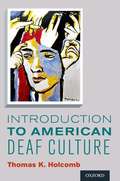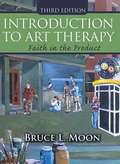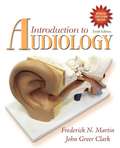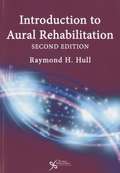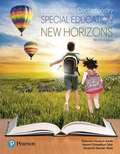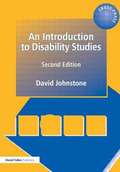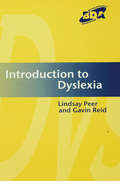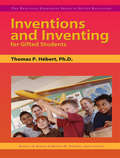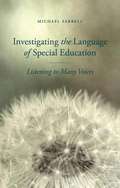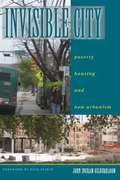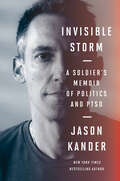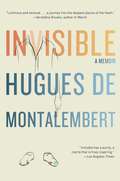- Table View
- List View
Introduction to American Deaf Culture (Professional Perspectives on Deafness: Evidence and Applications)
by Thomas K. HolcombIntroduction to American Deaf Culture is the only comprehensive textbook that provides a broad, yet in-depth, exploration of how Deaf people are best understood from a cultural perspective, with coverage of topics such as how culture is defined, how the concept of culture can be applied to the Deaf experience, and how Deaf culture has evolved over the years. Among the issues included are an analysis of various segments of the Deaf community, Deaf cultural norms, the tension between the Deaf and disabled communities, Deaf art and literature (both written English and ASL forms), the solutions being offered by the Deaf community for effective living as Deaf individuals, and an analysis of the universality of the Deaf experience, including the enculturation process that many Deaf people undergo as they develop healthy identities. <p><p> As a member of a multigenerational Deaf family with a lifetime of experience living bi-culturally among Deaf and hearing people, author Thomas K. Holcomb enhances the text with engaging stories interwoven throughout. In addition to being used in college-level courses, this book can also help parents and educators of Deaf children understand the world of Deaf culture. It offers a beautiful introduction to the ways Deaf people effectively manage their lives in a world full of people who can hear.
Introduction to Art Therapy: Faith in the Product
by Bruce L. MoonThis book describes the essential elements of the process of facilitating therapeutic change in forming a foundation from which art therapists construct treatment plans and philosophies. Enhancements in this text include: an overview of the spectrum of theoretical orientations within art therapy; a brief history of practice in the United States; descriptions of applications that were not widely understood in 1994; and the most current and seasoned interpretation of how the author perceives the art therapy experience. In addition, the author presents exceptional case examples including client-prepared artwork that highlights the text. This book will inspire serious artists to become involved in art therapy, and encourage veteran art therapists to renew their vocations by living the process of art therapy. This book will be a valuable resource to medical and mental health professionals, occupational therapists, and other rehabilitation professionals that aspire to become more effective in reaching others.
Introduction to Audiology (10th edition)
by Frederick N. Martin John Greer ClarkThe ninth edition of Martin's (U. of Texas at Austin) and Clark's (U. of Cincinnati) textbook features updated material throughout the text, including more detailed discussions of recent objective measures; new material on licensing/certification, outcome measures, and evidence-based practice; a revised discussion of the rapidly evolving measures of auditory evoked potentials; and separate discussions of pediatric and adult hearing aid selection/verification and hearing loss management.
Introduction to Aural Rehabilitation (Second Edition)
by Raymond H. HullNow in its second edition, Introduction to Aural Rehabilitation continues to provide all the elements necessary for a comprehensive, practice-oriented course in the habilitation/rehabilitation of children, adults, and the elderly with impaired hearing. This user-friendly text focuses on the most important clinical and practical aspects of providing services to the hearing impaired, while avoiding the technical detail of theoretical texts. . This second edition offers more in-depth information on cochlear implantation-including surgical procedures as well as the benefits for children and adults-and is approached from an amplification standpoint across several chapters by new contributing authors. . New and expanded information for Introduction to Aural Rehabilitation, Second Edition, includes the following topics: Speech development for children with impaired hearing; Listening and language development for children with impaired hearing; Hearing aids and non-hearing aid assistive listening devices; Hearing aids for children with impaired hearing; Educational management of children with impaired hearing; Non-hearing assistive listening devices for adults; Physiology and psycho-social impact of hearing loss in older adulthood; Rehabilitation procedures for adults with impaired hearing; and Expanded appendixes on communication scales and questionnaires
Introduction to Communicative Disorders (4th edition)
by M. N. HegdeIn this update of the 2001, 1995, and 1991 editions, Hegde (communication sciences and disorders, California State U. , Fresno) introduces the rapidly growing science of communication and profession of communicative disorders. Coverage includes a new chapter on literacy skills in children and the role of the speech-language pathologist in literacy intervention; profiles of speech-language pathologists and audiologists; and expanded material on audiology, audiology rehabilitation, and disorders of swallowing. The text includes study questions; information on professional education, organizations, and standards; a glossary.
Introduction to Contemporary Special Education: New Horizons
by Deborah Smith Naomi Tyler Kimberly SkowIntroduction to Contemporary Special Education: New Horizons presents an introduction to the professional practices, trends, and research that define contemporary special education while also conveying the diversity and excitement of this changing field.
Introduction to Disability Studies
by David JohnstoneAn introductory text that explores the current issues in the lives and circumstances of disabled people, their careers, and those who intend to work in the caring services. Explores and analyzes quality of life factors, the emergence of rights, and the strengths and weakness of community care provisions. Also provides examples of individual oppressions and success stories, and suggests how disabled and non-disabled people can collaborate in the development of inclusive communities and neighborhoods. Distributed by Taylor & Francis. Annotation c. by Book News, Inc., Portland, OR.
Introduction to Dyslexia
by Gavin Reid Lindsay PeerThis work provides the class teacher with a straightforward introduction to dyslexia. The authors highlight methods of identification of dyslexia within the classroom context and provide examples of how dyslexia can be dealt with by the class teacher.
Introduction to Locomotor and Multiple Disabilities - TNOU (Course 4 / 03 #SED-16)
by Tamil Nadu Open UniversityThe course aims to develop understanding about planning effective educational programme and functional activities for students with locomotor and multiple disabilities. This course intends to develop required skills in teacher trainee to identify the children with locomotor and multiple disabilities and also plan an effective programme education as well as for creating awareness on these conditions. Teacher is also expected to plan an effective therapeutic and programme and also refer for medical intervention whenever if necessary.
Introduction to Neuro Development Disabilities -TNOU (Course 4 / 02 #SED-15)
by Tamil Nadu Open UniversityThe course integrates relevant subject matter in the areas of Learning Disability, intellectual Disability and Autism Spectrum Disorder. This course will prepare preservice teachers to work with students with Neuro Developmental disabilities in inclusive and specialized settings. It fosters the acquisition of the broad-based knowledge and skills needed to provide effective educational programs for students with learning and behavior characteristics. The course emphasizes implications for educational and vocational programming, curriculum, and instruction.
Introduction to Sensory Disabilities - TNOU (Course 4 / 01 #SED-14)
by Tamil Nadu Open UniversityThis Course consists of Five Units dealing with Psycho-social and Family issues of Children with Hearing Impaired. Mainly the need and importance of psychosocial development of children with hearing impairment; the role of family, peers, and community in the psychosocial development of CWHI; family needs in parenting the children with hearing impairment; family empowerment and involvement in educational and community based rehabilitation programmes for children with hearing impairment. As a parent and as a teacher everyone should know about these details.
Introduction to Special Education: Making a Difference (7th edition)
by Deborah Deutsch Smith Naomi Chowdhuri TylerStudents and teachers have long relied on this comprehensive overview of the field of special education and the ways in which all teachers can help students with special needs to succeed in school and reach their full potential.
Introduction to Special Educational Needs, Disability and Inclusion: A Student′s Guide
by Joanne Smith Alexandra SewellThis essential textbook equips you with a strong understanding of theories, policies and practices and how they impact on Special Educational Needs and Disabilities, guiding you through your SEND course or modules. It provides you with the foundations and tools necessary to think critically about the issues and developments concerning SEND, inclusion, and professional practice. The book includes: - Material surrounding mental health in childhood and adolescence - Chapters on global perspectives of SEND, and assistive technologies - Practical case studies, reflection questions and activities - Spotlights on key theories and research - Up-to-date information on policies impacting SEND
Introduction to Special Educational Needs, Disability and Inclusion: A Student′s Guide
by Joanne Smith Alexandra SewellThis essential textbook equips you with a strong understanding of theories, policies and practices and how they impact on Special Educational Needs and Disabilities, guiding you through your SEND course or modules. It provides you with the foundations and tools necessary to think critically about the issues and developments concerning SEND, inclusion, and professional practice. The book includes: - Material surrounding mental health in childhood and adolescence - Chapters on global perspectives of SEND, and assistive technologies - Practical case studies, reflection questions and activities - Spotlights on key theories and research - Up-to-date information on policies impacting SEND
Introductory Phonetics and Phonology: A Workbook Approach
by Linda I. HouseSuccess in mastering any language requires knowledge in speaking, reading, and writing the language. The speaking component requires the understanding and use of correct pronunciation, emphasis, and syntactic patterns. The written component requires mastery of the alphabet, spelling, and the ability to write, print, or type the pattern. Very early in the learning process, speakers of the English language become keenly aware of the language's lack of sound to symbol correspondence. To help speech/language researchers, media personnel, individuals learning English as a second language, and others interested in correct pronunciation, the International Phonetic Alphabet (IPA) was devised. Extensively class tested, this book offers a practical understanding approach to phonetics and the IPA in a workbook format. It will be welcomed by professionals, students, and trainees in the fields of communication science, communication disorders, speech pathology, and linguistics.
Inventing Benjy: William Faulkner’s Most Splendid Creative Leap
by Frédérique SpillInventing Benjy: William Faulkner’s Most Splendid Creative Leap is a groundbreaking work at the intersection of Faulkner studies and disability studies. Originally published in 2009 by Presses de la Sorbonne Nouvelle as L’Idiotie dans l’œuvre de Faulkner, this translation brings the book to English-language readers for the first time. Author Frédérique Spill begins with a sustained look at the monologue of Benjy Compson, the initial first-person narrator in Faulkner’s The Sound and the Fury. Spill questions the reasons for this narrative choice, bringing readers to consider Benjy’s monologue, which is told by a narrator who is deaf and cognitively disabled, as an impossible discourse. This paradoxical discourse, which relies mostly on senses and sensory perception, sets the foundation of a sophisticated poetics of idiocy. Using this form of writing, Faulkner shaped perspective from a disabled character, revealing a certain depth to characters that were previously only portrayed on a shallow level. This style encompasses some of the most striking forms and figures of his leap into modern(ist) writing. In that respect, Inventing Benjy thoroughly examines Benjy’s discourse as an experimental workshop in which objects and words are exclusively modelled by the senses. This study regards Faulkner’s decision to place a disabled character at the center of perception as the inaugural and emblematic gesture of his writing. Closely examining excerpts from Faulkner’s novels and a few short stories, Spill emphasizes how the corporal, temporal, sensorial, and narrative figures of "idiocy" are reflected throughout Faulkner’s work. These writing choices underlie some of his most compelling inventions and certainly contribute to his unmistakable writing style. In the process, Faulkner’s writing takes on a phenomenological dimension, simultaneously dismantling and reinventing the intertwined dynamics of perception and language.
Inventing the Feeble Mind: A History of Mental Retardation in the United States
by James W. TrentJames W. Trent uses public documents, private letters, investigative reports, and rare photographs to explore our changing perceptions of mental retardation over the past 150 years. He contends that the economic vulnerability of mentally retarded people (and their families), more than the claims made for their intellectual or social limitations, has determined their institutional treatment.
Inventions and Inventing for Gifted Students
by Thomas P. Hébert Kristen Stephens Frances KarnesInventing involves creativity applied to a problem-solving process, which can be taught. Through teaching instructional units on inventing, multiple creative skills are infused into one unit. Teachers who provide their students with such instruction see inventions as a natural way of packaging creativity training in an authentic and meaningful way. Applying creative thinking skills and a knowledge of a field of study to create exciting inventions is at the heart of the inventing process. This guide offers a practical introduction to the inventing process: getting students interesting in inventing, teaching the inventing process, patenting new product ideas, participating in inventions conventions and competitions, and an extensive listing of print and Web-based resources. This is one of the books in Prufrock Press' popular Practical Strategies Series in Gifted Education. This series offers a unique collection of tightly focused books that provide a concise, practical introduction to important topics concerning the education of gifted children. The guides offer a perfect beginner's introduction to key information about gifted and talented education.
Investigating the Language of Special Education
by Michael FarrellUtilising a wide range of theoretical traditions from philosophy, sociology and anthropology, this book aims to raise the reader's awareness of the power as well as the limitations of language in relation to special education.
Investigations in Clinical Phonetics and Linguistics
by Nigel Hewlett Fay Windsor M. Louise KellyInvestigations in Clinical Phonetics and Linguistics is a sequel to the eighth meeting of the International Clinical Phonetics and Linguistics Association, attended by delegates from 26 different countries. This book reflects the scope of the subject area of clinical phonetics and linguistics, the balance of input into it with respect to the different kinds of research being carried on, and the representation of researchers from different parts of the world. Its scope includes the application of all levels of linguistic analysis and the chapters of the book have been ordered as far as possible according to linguistic level, beginning with pragmatics and ending with acoustics. It will be immediately apparent that a greater number of chapters are concerned with applications of phonetics and phonology then with any other levels.
Invisible City
by John Ingram GilderbloomA legendary figure in the realms of public policy and academia, John Gilderbloom is one of the foremost urban-planning researchers of our time, producing groundbreaking studies on housing markets, design, location, regulation, financing, and community building. Now, in Invisible City, he turns his eye to fundamental questions regarding housing for the elderly, the disabled, and the poor. Why is it that some locales can offer affordable, accessible, and attractive housing, while the large majority of cities fail to do so? Invisible City calls for a brave new housing paradigm that makes the needs of marginalized populations visible to policy makers. Drawing on fascinating case studies in Houston, Louisville, and New Orleans, and analyzing census information as well as policy reports, Gilderbloom offers a comprehensive, engaging, and optimistic theory of how housing can be remade with a progressive vision. While many contemporary urban scholars have failed to capture the dynamics of what is happening in our cities, Gilderbloom presents a new vision of shelter as a force that shapes all residents.
Invisible Illnesses and Disabilities: Rebuilding Your Life By Learning To Live with A Non-Terminal Life-Altering Situation
by Sharon SmithLearning to live with invisible illnesses and disabilities
Invisible Me
by Tzipi CatonA teenage girl is a selective mute. Her teachers think she's rude, her classmates think she's weird, and her siblings call her "socially suicidal." She must navigate her way through a new school, and a rocky relationship with her mother, and classmates who act as if she doesn't exist.
Invisible Storm: A Soldier's Memoir of Politics and PTSD
by Jason KanderFrom political wunderkind and former army intelligence officer Jason Kander comes a haunting, powerful memoir about impossible choices—and how sometimes walking away from the chance of a lifetime can be the greatest decision of all. <p><p>In 2017, President Obama, in his final Oval Office interview, was asked who gave him hope for the future of the country, and Jason Kander was the first name he mentioned. Suddenly, Jason was a national figure. As observers assumed he was preparing a run for the presidency, Jason announced a bid for mayor of Kansas City instead and was headed for a landslide victory. But after eleven years battling PTSD from his service in Afghanistan, Jason was seized by depression and suicidal thoughts. He dropped out of the mayor’s race and out of public life. And finally, he sought help. <p><p>In this brutally honest second memoir, following his New York Times best-selling debut Outside the Wire, Jason Kander has written the book he himself needed in the most painful moments of his PTSD. In candid, in-the-moment detail, we see him struggle with undiagnosed illness during a presidential bid; witness his family buoy him through challenging treatment; and, giving hope to so many of us, see him heal. <p> <b>New York Times Bestseller</b>
Invisible: A Memoir
by Hugues De MontalembertThe impressionistic memoir of an artist who was blinded in a sudden act of violence, leading to a profound meditation on what it means to see and be seen. "You live in a city like New York. You read the papers. You look at the television. But you never think it will happen to you. It happened to me one evening. " One summer night in 1978, Hugues de Montalembert returned home to his New York City apartment to find two men robbing him. In a violent struggle, one of the assailants threw paint thinner in Hugues' face. Within a few hours, he was completely blind. Eloquent and provocative, Invisible moves beyond the horrific events of that night to what happened to Hugues after he lost his sight: his rehabilitation, his solo travels around the world, and the remarkable way he learned to "see" even without the use of his eyes. Without a trace of self-pity, Hugues describes his transition from an up-and-coming painter to a blind man who had to learn to walk with a cane. His status changed in the eyes of other people as their reactions ranged from avoidance to making him their confidant. Hugues traveled to faraway places and learned to trust strangers and find himself at home in any situation. Part philosophy, part autobiography, part inspiration, Invisible will change the way readers understand reality and their place in the world.
